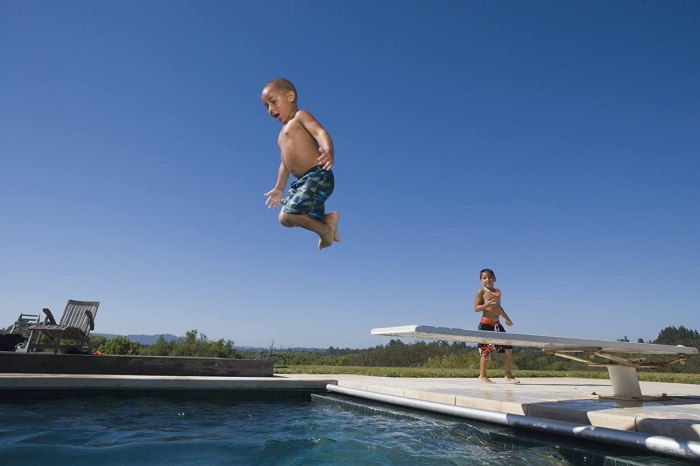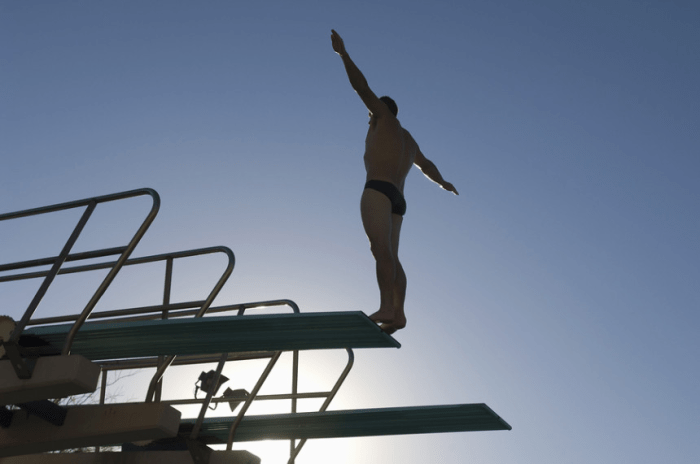A diver leaves the end of a 4.0-m-high diving board – With a diver poised at the end of a 4.0-meter diving board, this exploration delves into the intricacies of this daring feat. From the physical forces at play to the psychological challenges involved, this analysis provides a comprehensive overview of the art and science behind diving from a 4.0-meter
height.
The subsequent paragraphs will delve into the significance of the diving board’s height, the diver’s position, and the various diving techniques employed. We will examine the impact of the dive on the diver’s body and explore the safety considerations and historical context surrounding this exhilarating activity.
A Diver Leaves the End of a 4.0-m-High Diving Board

When a diver stands at the end of a 4.0-meter-high diving board, they are poised to execute a variety of acrobatic maneuvers before entering the water below. The height of the diving board, the diver’s position, and the diving technique all play a role in determining the outcome of the dive.
The Height of the Diving Board
The height of the diving board is significant because it determines the amount of time the diver has to complete their rotations and the amount of force they will experience upon entering the water. A 4.0-meter diving board is considered to be a medium-height board, suitable for divers of all skill levels.
Higher diving boards, such as 10-meter boards, allow divers to perform more complex maneuvers and generate greater speed upon entry into the water. However, higher boards also increase the risk of injury.
The Diver’s Position
The diver’s position at the end of the diving board is crucial for a successful dive. The diver should stand with their feet shoulder-width apart and their knees slightly bent. Their arms should be extended overhead, with their hands clasped together.
The diver’s body should be in a straight line from their head to their toes. This position helps to minimize drag and allows the diver to enter the water cleanly.
The Diving Technique
There are a variety of diving techniques that can be used from a 4.0-meter diving board. Some of the most common techniques include:
- Front dive: The diver enters the water headfirst with their arms extended overhead.
- Back dive: The diver enters the water backfirst with their arms extended overhead.
- Somersault: The diver performs a forward or backward somersault before entering the water.
- Twist: The diver performs a twist or flip before entering the water.
The choice of diving technique depends on the diver’s skill level and the desired outcome of the dive.
The Impact of the Dive, A diver leaves the end of a 4.0-m-high diving board
When a diver enters the water from a 4.0-meter height, they experience a significant amount of force. The impact of the dive can cause the diver’s body to compress and their muscles to tense up.
The impact of the dive can also cause the diver to experience a brief period of disorientation. This is because the diver’s brain is trying to adjust to the sudden change in pressure.
Safety Considerations
Diving from a 4.0-meter diving board can be a dangerous activity. It is important to take the following safety precautions:
- Always dive into deep water.
- Never dive headfirst into shallow water.
- Be aware of other divers in the water.
- Follow the instructions of the lifeguards.
By following these safety precautions, divers can help to reduce the risk of injury.
Psychological Aspects
Diving from a 4.0-meter diving board can be a daunting task. Divers may experience feelings of fear, anxiety, and even panic.
It is important for divers to develop mental preparation techniques to help them overcome these challenges. These techniques may include visualization, positive self-talk, and relaxation exercises.
Historical Context
Diving from 4.0-meter diving boards has a long history. The first diving boards were used in the early 1900s. These boards were made of wood and were much shorter than the boards used today.
Over the years, diving boards have evolved to become safer and more efficient. Today, diving boards are made of a variety of materials, including metal, fiberglass, and carbon fiber.
Cultural Significance
Diving from 4.0-meter diving boards has cultural significance in many countries around the world. In some cultures, diving is seen as a rite of passage. In other cultures, diving is seen as a form of entertainment.
Diving from 4.0-meter diving boards is a challenging and rewarding activity. By understanding the physics of diving, divers can improve their technique and reduce the risk of injury.
Key Questions Answered: A Diver Leaves The End Of A 4.0-m-high Diving Board
What is the significance of the 4.0-meter height for diving boards?
The 4.0-meter height is a common standard for diving competitions and provides an appropriate level of challenge for divers while ensuring safety.
How does the diver’s position affect their entry into the water?
The diver’s position influences their body alignment and rotation during entry, impacting the splash and overall dive score.
What are some common diving techniques used from a 4.0-meter diving board?
Forward dives, back dives, and inward dives are among the fundamental techniques used from this height, each requiring specific body movements and coordination.
What are the potential risks and benefits of diving from a 4.0-meter height?
While diving from this height can be exhilarating, it also carries risks such as injury from improper entry or shallow water. However, it also offers benefits like improved coordination, physical fitness, and a sense of accomplishment.


